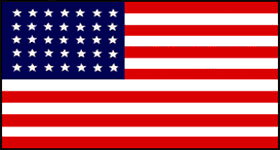 |
Civil War Battles |
|
State War Records |
| AL - AK - AZ - AR - CA - CO - CT - DE - FL - GA - HI - ID - IL - IN - IA - KS - KY - LA - MA - MD - ME - MI - MN - MS - MO - MT - NE - NV - NH - NJ - NM - NY - NC - ND - OH - OK - OR - PA - RI - SC - SD - TN - TX - UT - VT - VA - WA - WV - WI - WY |
The Battle of Ezra Church
July 28, 1864 in Fulton County, Georgia (aka the Battle of Ezra Chapel and the Battle of the Poor House)
 |
|||||||||||||||||
|
Though Lt. Gen. John B. Hood's savage sorties on July 20 and 22 failed to wreck a portion of Maj. Gen. William T. Sherman's army and drive him away from Atlanta, they did, with the help of Atlanta's strong fortifications, block the Union drives on the city from the north and east. Consequently, Sherman looked to the west.
Between July 25-27, Sherman transferred the Army of the Tennessee, now commanded by Maj. Gen. Oliver O. Howard, from his left to his right wing, ordering it on September 28 to advance and cut the railroad between Atlanta and East Point, Hood's only remaining supply line.
Sherman's army stretched in a inverted "U" around the northern defenses of Atlanta. He decided to cut off the railroad supply lines from Macon into Atlanta, thus forcing the Confederate army to withdraw without a direct assault. To accomplish this goal, Sherman commanded the Army of the Tennessee north and west around the rest of the Union lines to the far western side of Atlanta where the railroad entered the city.
Hood detected this maneuver and moved his troops out to oppose the Union army. Hood planned to intercept them and catch them completely by surprise. He sought to turn it to Confederate advantage by sending portions of 2 corps, belonging to Lt. Gen. Stephen D. Lee and Lt. Gen. A.P. Stewart, to ambush Howard's column southwest of Atlanta. Although his Confederate troops were outnumbered by the main Union army, he calculated that a surprise attack against an isolated portion of the Union army could succeed.
On July 28, Lee's corps, followed by Stewart's, attacked Howard near a chapel called Ezra Church in the afternoon. Instead of striking the Union open flank as planned, the Confederates ran against the front of Maj. Gen. John A. Logan's XV Corps, which, in anticipation of the Confederate move, had formed a barricaded line at a right angle to the rest of Howard's force.
Unfortunately for Hood, there was no surprise for Howard. Howard had predicted such a maneuver based on his knowledge of Hood. Howard's troops were already waiting in their trenches when Hood reached them. The Confederate army charged, but fell back before the Union army's improvised breastwork of logs and rails. Although the Confederate troops for the most part charged with their usual bravery, their attempt to overrun Logan was futile. Further, a misleading map prevented Sherman from falling on the left flank of the attacking force, thereby totally destroying it and opening the way for the quick capture of Atlanta.
Hood's foray at Ezra Church did not stop Sherman from cutting Atlanta's supply line, but the heavy losses suffered by the Confederates in this and their previous sorties destroyed their offensive power and spirit. Henceforth, Hood did not have any choice but to stand on the defensive. The Battle of Ezra Church was also known as the Battle of the Poor House.
